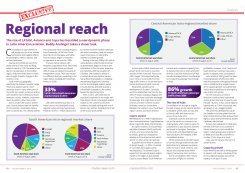ROUTES AMERICAS: Industry Interview - Eduardo Iglesias, Executive Director, The Latin American and Caribbean Air Transport Association (ALTA)
FROM THE LATEST ISSUE OF ROUTES NEWS: Our sister publication speaks to Eduardo Iglesias, Executive Director, The Latin American and Caribbean Air Transport Association (ALTA).
What are the biggest challenges facing aviation in the region?
Continuing to operate efficiently and safely using infrastructure that is often barely able to handle growing air traffic. The application of antitrust regulations, taxation and overcharging of fuel and other airport related services, as well as diverse consumer rights legislations, are also challenging. Our region is full of different antitrust regulations and policies that prevent many practices that are accepted in other parts of the world. This limits our ability to compete on a level playing field.
Are Latin American airports prioritising infrastructure enough?
As a point of reference, China has 94 airports under construction or being expanded. Latin America, with its growth rate of 6.5%, which is very close to China’s, has 16 airports under construction or being expanded in the same period. We know over 30% of flights in the region either depart from or land in an oversaturated airport.
What has been ALTA’s industry highlight over the past year?
We continue to improve safety, demonstrated by a record of five consecutive years without fatal accidents among the IOSA-registered airlines. We recognise the need for carriers that can’t fulfill IOSA requirements because of their fleets, but still wish to meet higher safety standards, to have access to a different set of audits. We helped drive an initiative that culminated in the creation of ISSA (IATA Safety Standard Assessment), which will help to meet the needs of another tier of airlines. We have also secured the shared information of 85% of all flights in the region, allowing us to identify more accurately any risk areas, which in turn makes it possible to implement programmes that help mitigate high-risk incidents. ALTA was also actively involved in opposing, and obtaining the repeal of, several fuel taxation initiatives and airport fees.
Is ALTA confident Brazilian airports will be ready to welcome visitors to the World Cup?
Although Brazil has taken steps to meet travel demand for the 2014 World Cup and the 2016 Olympics, there are still many concerns these will only be a temporary fix to what is a major infrastructure bottleneck. If you look at the traffic growth opportunities in Brazil over the next 20 years and compare those to what can be achieved with the current infrastructure, even after recent investments, it is clear that the positive effects of aviation may not reach many communities.
What has been the most significant change in the Latin American airline landscape?
Consolidation and the building of alliances. Ten years ago, there were 101 airlines in the region, with three involved in alliances. Today, we have 79 airlines and two thirds of the region’s ASKs are flown by airlines in global alliances. The 10 largest groups in the region represent nearly 90% of the region’s capacity. Consolidation has benefitted the consumer, as efficiencies and seamless connections often result in lower fares.
Are airports partnering with tourism authorities on route development initiatives?
There is a growing interest from local tourism authorities in developing connectivity and new opportunities to promote cities and countries. Ten years ago, there were only 687 city pairs being served within the region, including the Caribbean. Today, there are more than 953 and growing.
 |
DON'T MISS the latest issue of Routes News which is available at this year's Routes Americas and includes an EXCLUSIVE report on the Latin America aviation industry. Click here to view the digital version of the magazine. |  |
